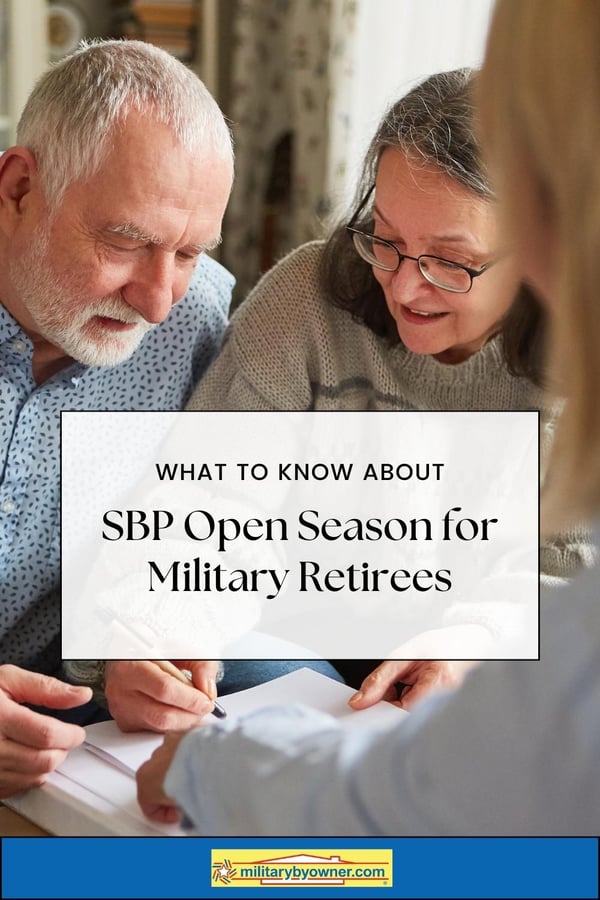What to Know About the SBP Open Season for Military Retirees
Note this important update from the Defense Finance and Accounting Service, as of October 2023:
"November 1, 2023 – Request for Individual Estimate Deadline (LOI)
Retirees who want an individual estimate prior to officially enrolling should submit their Letter of Intent (LOI) no later than November 1, 2023. If we do not receive the LOI by November 1, we may not be able to provide an individual estimate in time for you to enroll by the deadline. We strongly recommend you upload your LOI via our askDFAS online upload tool. Please note: You can enroll without getting an individual estimate." Learn more here.
Big news for military retiree families!
During a unique Open Season in 2023, you have an opportunity to revisit your Survivor Benefit Plan decision. Every military family should take at least a few minutes to make sure they truly understand all the pros and cons of the military’s Survivor Benefit Plan and think about whether the decision you made at retirement is still the right decision for their family’s unique financial needs.
Military retirement pay ends with the death of the service member. For survivors to continue receiving any income from the Department of Defense, the retiree must be enrolled in SBP at the time of their death. Under normal rules, the only time a retiree can opt in to SBP is at the time of retirement unless they have very specific beneficiary changes. But during this unique Open Season in 2023, retirees may buy back into SBP if they did not elect coverage at retirement.

Survivor Benefit Plan Basics
SBP is simple, and yet it can be hard to be sure you understand all the nuances. I’ll give you a brief overview here, but I suggest you learn everything there is to know about SBP before making any decisions.
SBP provides inflation-adjusted monthly income to eligible designated beneficiaries. Depending on their beneficiary status, that income may continue for their lifetime. This income can be an important part of a surviving family’s financial picture.
SBP Eligible Beneficiaries
Eligible beneficiaries include spouses, former spouses, spouses and child(ren), former spouses and children, child(ren) alone, and insurable interest. (Insurable interest coverage is very different from other coverage and is not part of this article.) A retiree may cover one eligible beneficiary group, and may not change designations unless there is a qualifying event such as a death or divorce. If spouse/former spouse and child(ren) coverage is elected, the spouse is the primary beneficiary and the child(ren) is/are secondary beneficiaries.
How Are SBP Benefits and Premiums Calculated?
When enrolling in the Survivor Benefit Plan program, the family decides what portion of military retirement pay they want to have benefits and premiums calculated on. This elected amount may be called the “elected amount” or the “covered amount.” The elected amount can be anywhere from $300 to full retirement pay. Benefits are 55% of the elected amount. The maximum benefit is 55% of gross military retirement pay.
The premium is also based on this elected amount. For spouses and former spouses, the monthly premium is 6.5% of the covered amount. Adding child coverage to spouse coverage is very inexpensive, typically less than $1 per month, because the child coverage is secondary to the spouse coverage. Child only coverage, which is primary coverage, is based on the age of the child and the age of the retiree.
For example, Julia is a Navy retiree. She is married to Tomas and has two children, Erica and Juan. At retirement, Julia elected spouse and child coverage at 100% of her gross military retirement pay. If Julia dies, her military retirement pay ends. As long as Tomas is still eligible, he will receive 55% of Jula’s retirement pay. If for some reason Tomas can’t receive benefits, Julia’s benefit will be split between Erica and Juan. When Erica ages out, Juan would then get the whole benefit until he ages out.
Why Is There An Open Season for the Survivor Benefit Plan?
As a rule, you can only opt in to SBP at retirement or if you acquire a new eligible dependent after retirement. There are very limited opportunities to disenroll in SBP.
However, there are very occasional changes to the SBP rules. When there is a major change to the SBP rules, Congress sometimes authorizes an Open Season. This allows retirees and their spouses to revisit their SBP decision in light of the new rules.
The 2020 National Defense Authorization Act changed the way the SBP worked with Dependency and Indemnity Compensation benefits received from the Department of Veterans Affairs. These changes were fully implemented in 2023, and so this Open Season was authorized.
But don’t be thinking that another Open Season will come around again in the future. There have only been four Open Seasons in the history of SBP, and the last one was in 2005. More importantly, Congress has worked out all the kinks in SBP and it is unlikely that there will be any major law changes in the future.
If you’ve reviewed your current SBP coverage and determine that you need to make changes, then head over to the DFAS Open Season website.
Why You Might Want To Opt In to SBP
There are many reasons why you might want to opt in to SBP. The first reason is because you didn’t understand the program fully at the time of military retirement. Retirement often feels like running in front of an avalanche, and checking the SBP block is one step in keeping that snowball from hitting you. If you didn’t understand SBP, or didn’t have time or energy to really get to know it, then this is a great chance to revisit your options.
Another reason you may want to opt in to SBP is because your alternate plans didn’t work out. Perhaps you were unable to get affordable life insurance, or you weren’t able to work enough years to amass the investment assets you planned.
Lastly, some people discover after retirement that they really do need that military retirement pay to make ends meet, and then realize that their survivors will struggle without it.
I’m sure there are other reasons, too!
Why You Might Want To Opt Out of SBP
The best reason to opt out of SBP is that you don’t need the benefit anymore. Your family has enough income and assets that military retirement pay is “bonus” money, and that income and those assets would continue for your survivors. Perhaps retirement allowed your spouse to flourish at their career, or you inherited assets, or you were able to really sock away a lot into investments, and SBP is now superfluous.
The worst reason to opt out of SBP is because you feel it is too expensive and you need that premium money in your budget right now. Because if you can’t live on 93.5% of your military retirement pay, how are your survivors going to live with 0% of your military retirement pay?
Opting In to SBP
If you are opting in to SBP, there is a four-step process.
First, you indicate your interest by submitting a Letter of Intent to Enroll. This is a non-binding application that DFAS will use to estimate your buy-in costs and monthly premium. This link will auto open the file, so don’t click on it if you aren’t in a good place to do that.
Then, DFAS will send you back the information you need to make a final decision. This includes buy-in costs and monthly premiums. Keep in mind that the months you buy will count to your 30-year premium maximum.
Step three is to officially notify DFAS of your request to be enrolled in SBP. The instructions will be included with the cost estimates.
Lastly, you’ll receive confirmation of your enrollment and instructions to pay the buy-in costs Depending on the elected level of coverage and how many years of premiums you need to repay, this could be a big number or a small number.
Opting Out of SBP
If your review of your overall financial situation shows that your survivors will have enough income and assets to not need the Survivor Benefit Plan, then opting out is a simple process. You simply submit the OPEN SEASON ELECTION TO DISCONTINUE PARTICIPATION form, found at the DFAS website, though the DFAS portal. You will be disenrolled.
A Caveat
There are barracks lawyers, battle buddies, and even financial “professionals” out there who will tell you all sorts of negative things about SBP. While the Survivor Benefit Plan is not the right tool for everyone, it is not a scam, a trick, or a bad deal. It’s not cheaper to buy comparable insurance. If your survivors’ financial plan needs potentially lifetime income, SBP may be the most affordable choice to provide the income they need.
However, opting into SBP after retirement represents a significant cost. Therefore, if you are considering opting in, you need to do a careful analysis of of the cost and benefit.
Note: the SBP Open Season runs through January 1, 2024.
Stay updated on important military topics like these. Subscribe to our newsletter below!





